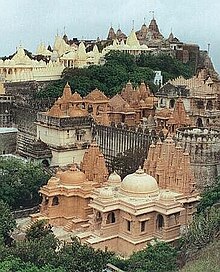
Back जैन मंदिर Bihari জৈন মন্দির Bengali/Bangla Templo jaina Spanish जैन मन्दिर Hindi 자이나교 사원 Korean Jaintempel NB ਜੈਨ ਮੰਦਰ Punjabi جین مندر PNB ජෛන පන්සල් Singhalese Tempulli xhainist Albanian

| Part of a series on |
| Jainism |
|---|
 |
A Jain temple, Derasar (Gujarati: દેરાસર) or Basadi (Kannada: ಬಸದಿ) is the place of worship for Jains, the followers of Jainism.[1] Jain architecture is essentially restricted to temples and monasteries, and Jain buildings generally reflect the prevailing style of the place and time they were built.
Jain temple architecture is generally close to Hindu temple architecture, and in ancient times Buddhist architecture. Normally the same builders and carvers worked for all religions, and regional and periodic styles are generally similar. For over 1,000 years, the basic layout of a Hindu or most Jain temples has consisted of a small garbhagriha or sanctuary for the main murti or idol, over which the high superstructure rises, then one or more larger mandapa halls.
Māru-Gurjara architecture or the "Solanki style", is a particular temple style from Gujarat and Rajasthan (both regions with a strong Jain presence) that originated in both Hindu and Jain temples around the year 1000, but became enduringly popular with Jain patrons. It has remained in use, in somewhat modified form, to the present day, indeed also becoming popular again for some Hindu temples in the 20th century. The style is seen in the groups of pilgrimage temples at Dilwara on Mount Abu, Taranga, Girnar, Kundalpur, Sonagiri, Muktagiri and Palitana.[2]
- ^ Babb, Lawrence A (1996). Absent lord: ascetics and kings in a Jain ritual culture. Published University of California Press. p. 66.
- ^ Hegewald